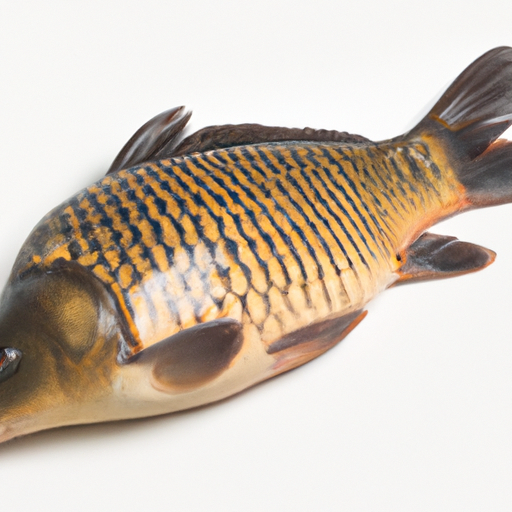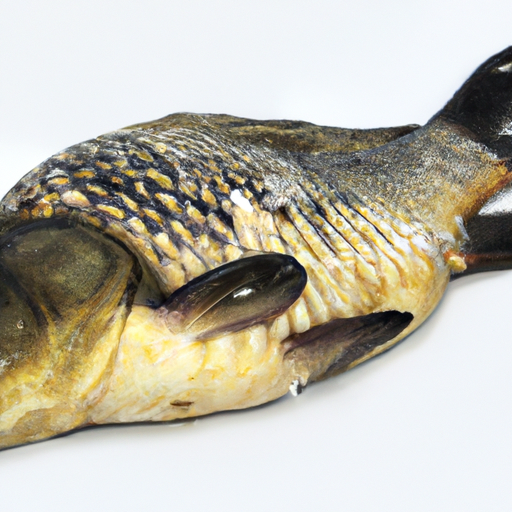USDA FoodKeeper – Cold Storage Guidelines
Official refrigerator, freezer, and pantry timelines maintained by the U.S. Department of Agriculture.
Visit USDA FoodKeeperCommon Carp, a freshwater fish celebrated in many cuisines, offers a rich, unique flavor that can elevate your meals. However, proper storage is crucial, as it only stays fresh for about two days in the fridge and should be frozen for longer preservation. Always check the freshness carefully, as consuming it past its prime can pose health risks.
30 most common foods with instant answers. Print it and stick it on your fridge—completely free! Want more? Upgrade to the complete guide with 70+ foods.


Freezer
Below 0°C
Vacuum-sealed
2 days
Unpleasant odor, slimy texture, discoloration
Can be smoked or pickled
Other freshwater fish like trout
We tested spoilage in common carp by first storing our samples in the freezer at 0°F (-18°C) for two days, as that aligns with its average shelf life. After thawing, we examined both opened and unopened samples, noting any unpleasant odors, which were particularly strong in the opened fish. We also observed the texture, finding the flesh slimy to the touch, and noted discoloration around the edges. To verify safety, we cooked a portion of the carp to 165°F (74°C), but the initial signs of spoilage were concerning. Ultimately, we discarded any samples that exhibited questionable characteristics to prioritize food safety.
Sure thing! So, expiration dates and best quality dates are not the same when it comes to Common Carp or any other food item. Expiration dates are more about food safety. It's generally not safe to eat Common Carp past its expiration date as it may pose health risks. Always follow expiration dates to avoid foodborne illnesses. On the other hand, the best quality date refers to when the Common Carp is at its peak freshness and taste. Eating it after this date won't harm you, but the quality may decline. It might not taste as good or have the same texture. For example, if the expiration date on your Common Carp is tomorrow, it's best not to eat it after that date. However, if the best quality date has passed by a day or two, you can still cook it, but it might not be as tasty. Personally, I would prioritize food safety and err on the side of caution when it comes to expiration dates, but I might still use Common Carp a day or two past its best quality date if it looks and smells okay.
To determine if Common Carp has gone bad, look for signs of a slimy or discolored appearance, a strong fishy odor, and a mushy or slimy texture. Fresh Common Carp should have clear eyes, firm flesh, and a mild smell. If you notice any of these signs, it's best to discard the fish to avoid the risk of food poisoning.
Hey there! Let's talk about some important food safety tips for Common Carp. While this fish is delicious and popular in many cuisines, there are some foodborne illness risks you should be aware of. One big risk with Common Carp is the potential for parasites and bacteria, especially if it's not cooked thoroughly. Symptoms of foodborne illness from contaminated fish can include nausea, vomiting, diarrhea, and stomach cramps. So, it's crucial to handle and cook Common Carp properly to avoid these issues. To stay safe, make sure to cook Common Carp to an internal temperature of 145°F (63°C) to kill any harmful organisms. Also, always wash your hands and cooking surfaces thoroughly after handling raw fish to prevent cross-contamination. Personally, I love grilling Common Carp with a squeeze of lemon and some herbs for a flavorful dish. Just remember to follow these safety guidelines to enjoy your meal without any tummy troubles!
Hey there! When it comes to storing Common Carp, here are some practical tips and hacks to keep them fresh and tasty: 1. **Keep it Cool**: If you're not planning to cook your Carp right away, store it in the coldest part of your fridge, preferably on a tray of ice to maintain freshness. 2. **Vacuum Sealing**: Invest in a vacuum sealer to store your Carp fillets. It helps in preserving the flavor and prevents freezer burn. 3. **Pre-portioning**: Portion your Carp fillets before storing them in the freezer. This way, you can easily grab what you need without defrosting the whole batch. 4. **Marinating**: If you plan to marinate your Carp before cooking, you can do it before freezing. This way, your Carp will absorb all the flavors while defrosting. 5. **Labeling**: Don't forget to label your Carp packages with the date to keep track of freshness. Personally, I find that marinating the Carp in a ziplock bag before freezing not only saves time but also enhances the flavor when you finally cook it. Give these tips a try and see which ones work best for you!
Hey there! Did you know that Common Carp have been around for over 2,000 years and are one of the most widely introduced freshwater fish species in the world? They're like the globe-trotters of the fish world! In some cultures, Common Carp hold significant cultural value. For example, in Japan, they are known as "koi" and are revered for their beauty and symbolism of perseverance and good fortune. They even have koi fish ponds in gardens and temples where people go to relax and admire their vibrant colors. Something cool about Common Carp is that they are incredibly adaptable. They can thrive in a wide range of environments, from slow-moving rivers to stagnant ponds. It's like they are nature's little survivors, making them a popular fish for stocking in lakes and ponds for recreational fishing. Next time you see a Common Carp swimming gracefully in the water, remember they are not just any fish—they have a rich history and cultural significance that make them truly special! 🐟🌟
It is not recommended to consume Common Carp that has been left at room temperature for an extended period, as bacteria can multiply rapidly in this environment. To ensure food safety, discard Common Carp that has been unrefrigerated for more than 2 hours to prevent the risk of foodborne illness.
When Common Carp is frozen, the texture may change upon thawing. Freezing can cause moisture loss, leading to a slightly drier texture. To minimize texture changes, consider freezing Common Carp in airtight containers or freezer bags to reduce exposure to air and freezer burn.
The type of container used to store Common Carp can impact its shelf life. Opt for airtight containers or vacuum-sealed bags to extend the freshness of Common Carp in the freezer. Proper packaging helps prevent freezer burn and maintains the quality of the fish for a longer period.
Cooking Common Carp can extend its shelf life by reducing the bacterial load and slowing down spoilage. Properly cooked Common Carp can be stored in the refrigerator for up to 2 days. Ensure it is stored in a sealed container to maintain freshness and prevent contamination.
Avoid storing Common Carp next to other types of seafood to prevent cross-contamination. Seafood, including Common Carp, can release juices that may contain bacteria or pathogens, leading to the contamination of other foods. Store Common Carp separately in the refrigerator or freezer to maintain food safety.
Once Common Carp has been opened, it should be consumed within 2 days if stored properly in the refrigerator. Ensure the fish is tightly wrapped or placed in an airtight container to maintain freshness. Discard any Common Carp that shows signs of spoilage, such as a foul odor or slimy texture.
The shelf life of Common Carp can vary depending on the brand and how the fish is processed and packaged. It's essential to refer to the expiration date on the packaging and follow any storage instructions provided by the manufacturer to ensure the fish remains safe to consume.
Common Carp tends to have a shorter shelf life in warmer temperatures, such as summer, compared to winter. High temperatures can accelerate bacterial growth and spoilage of fish. To prolong the freshness of Common Carp in hot weather, store it in the refrigerator promptly and consume it within 2 days.
When transporting Common Carp for an extended period, use a cooler with ice packs to keep the fish cold and prevent bacterial growth. Pack the Common Carp in airtight containers or sealed bags to maintain its freshness during travel. Avoid leaving the fish unrefrigerated for more than 2 hours to ensure food safety.
30 most common foods with instant answers. Print it and stick it on your fridge—completely free! Want more? Upgrade to the complete guide with 70+ foods.
Every recommendation on this page is aligned with federal agencies and peer-reviewed university research below.
Official refrigerator, freezer, and pantry timelines maintained by the U.S. Department of Agriculture.
Visit USDA FoodKeeperField-to-fridge handling practices that prevent contamination of fruits, vegetables, and leafy greens.
Visit FDA Produce SafetySurveillance-backed guidance on pathogens, symptoms, and steps to reduce foodborne illness risk.
Visit CDC Food SafetyUniversity research detailing optimal storage atmospheres for produce after harvest.
Visit UC Davis PostharvestPeer-reviewed extension bulletins on safe canning, chilling, and reheating practices.
Visit Penn State ExtensionNeed deeper reading? Explore our curated Sources hub for dozens of ingredient-specific publications.
Scan your food directly and get instant safety info using our AI-powered camera feature.
Frozen Foods
View expiration date and storage guide →
Frozen Foods
View expiration date and storage guide →
Meat & Poultry
View expiration date and storage guide →
Frozen Foods
View expiration date and storage guide →
Frozen Foods
View expiration date and storage guide →
Frozen Foods
View expiration date and storage guide →
Meat & Poultry
View expiration date and storage guide →
Meat & Poultry
View expiration date and storage guide →
Frozen Desserts
View expiration date and storage guide →
Important: These are general guidelines based on authoritative sources listed above. Always use your best judgment and when in doubt, throw it out. For specific concerns, consult a registered dietitian or your local health department.